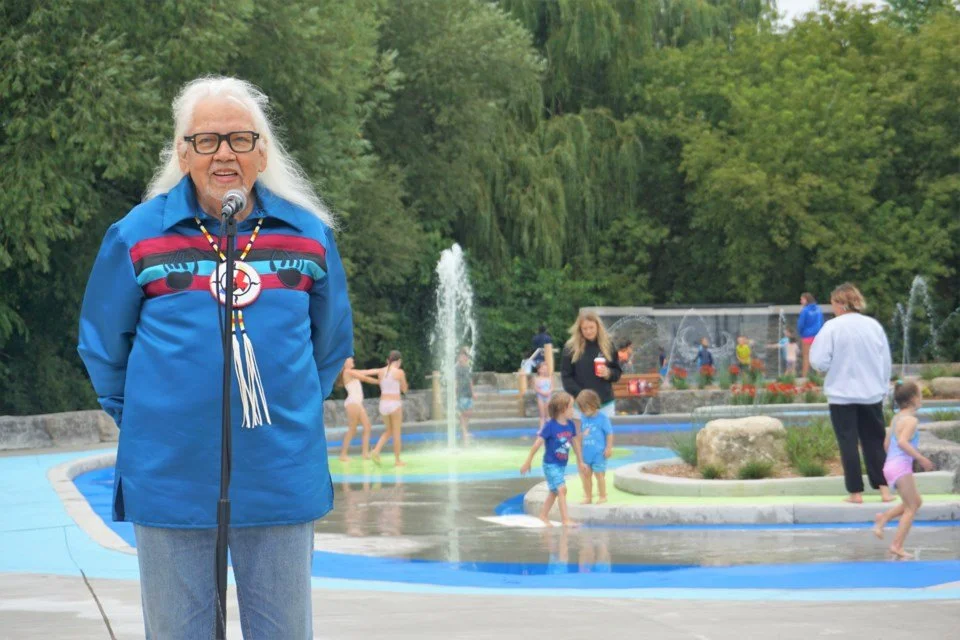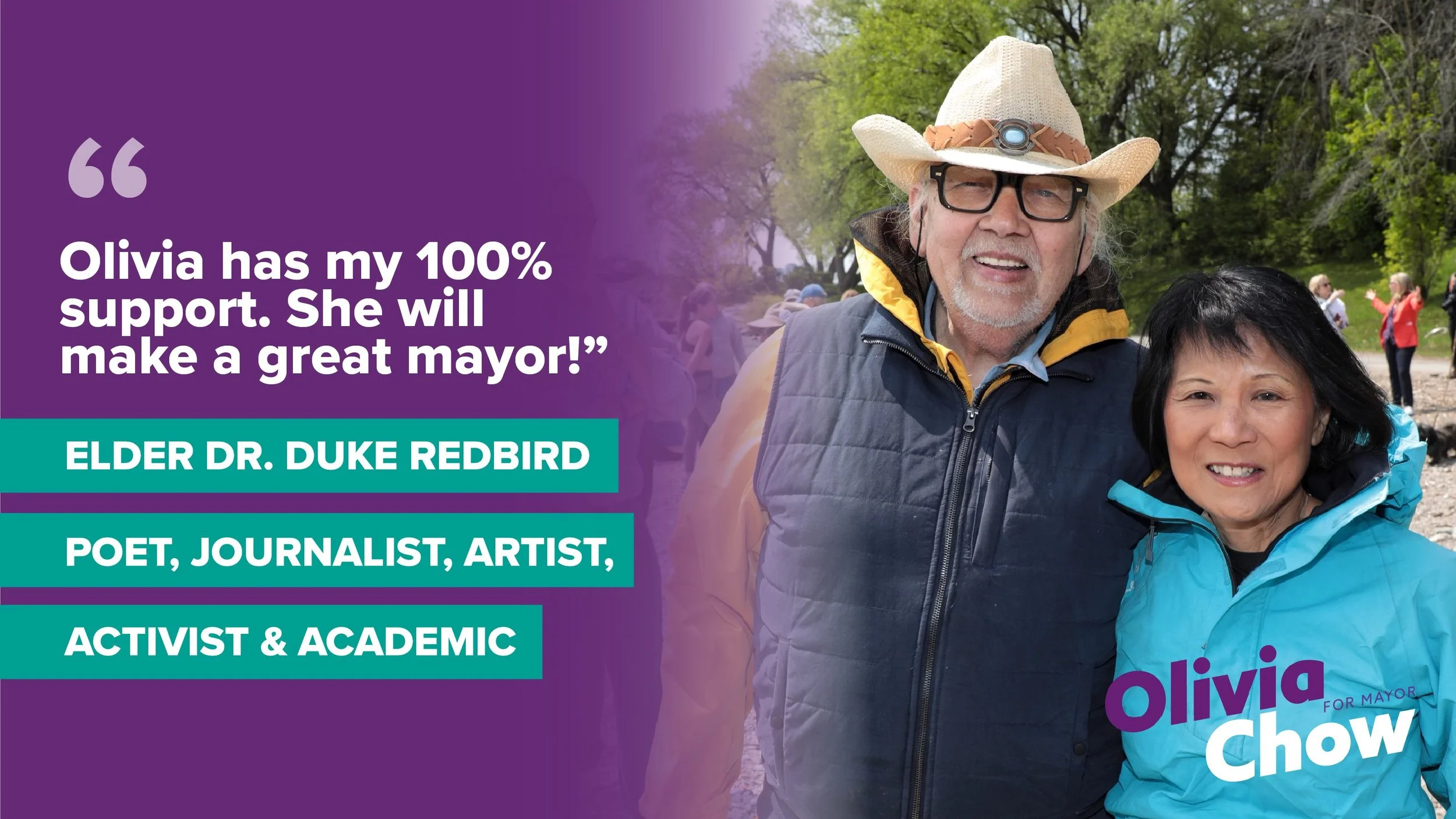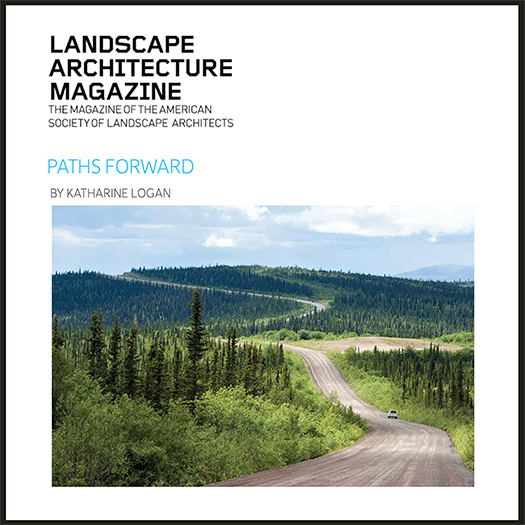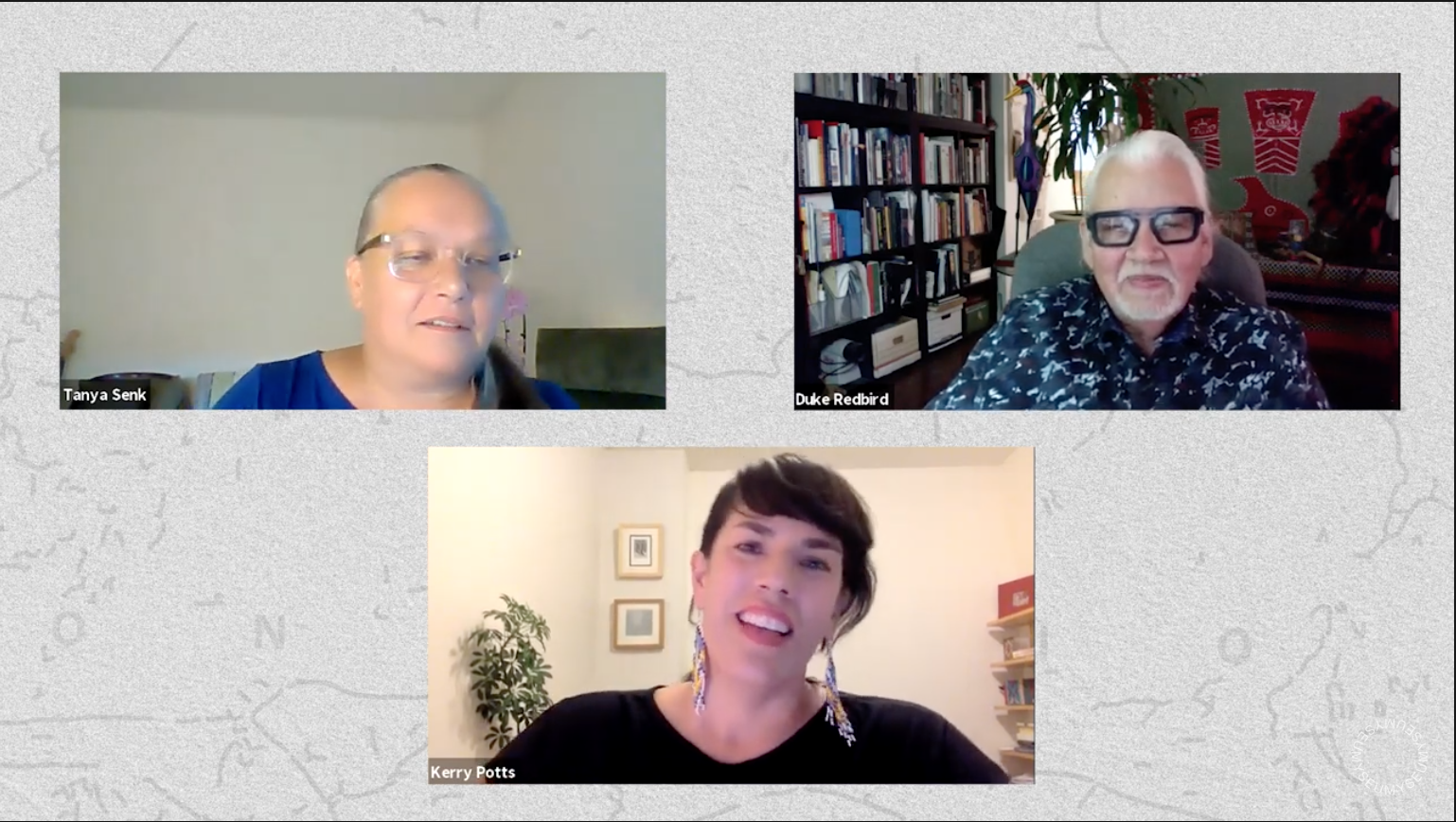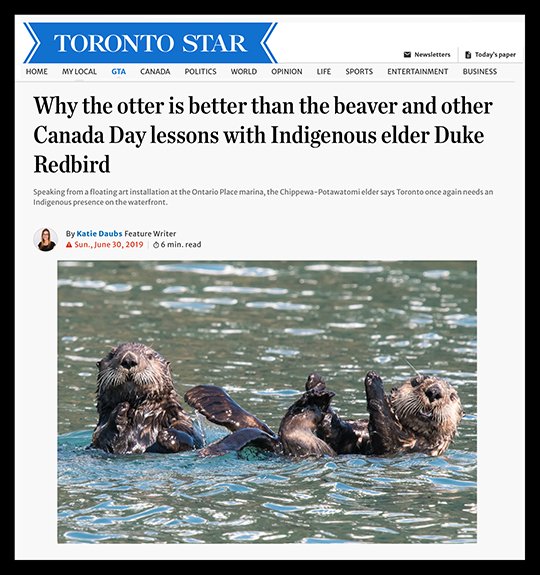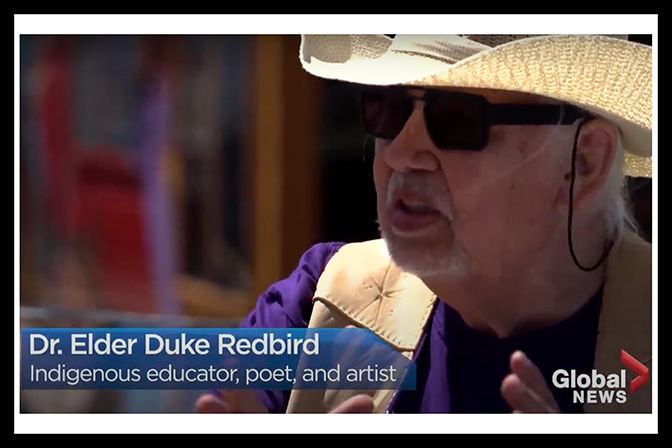How Elder Redbird Can Help Journalists and Other Media Professionals
Elder Redbird Is available to advise on a broad range of topics, including, but not limited to:
Arts and Culture in Canada
Indigenous Relations and history
Traditional Indigenous teachings and land acknowledgements
History of Tkaronto and a dish with one spoon
Note: Only inquiries from media entities will be considered; for any other requests, please contact us.
REcent press
Researchers say newly discovered archival records reveal an important connection between Ontario First Nations and Irish famine victims.
The Irish Potato Famine was a period of starvation and disease in Ireland, and one of the most traumatic events in modern Irish history. The part of this history that is virtually unknown is the contribution to the relief fund from Indigenous communities in Canada.
Duke Redbird, an elder from the Saugeen Ojibway Nation says his own community donated to the fund.
"They were as generous as they could be even though our people were in a pretty desperate situation themselves," he said.
"But it was an act of kindness, and it was an act of honouring the treaties with our white brethren who were suffering in Ireland at the time."
Global News marks National Indigenous Peoples Day with a special reading by Elder Duke Redbird. The poet, activist and educator is among the best known Indigenous voices in this country. The poem itself is called “The Power of the Land.”
Elder Duke Redbird shares Poem he wrote for national day for truth and reconciliation with Global news.
The Awen’ Waterplay Park Includes multiple water-play features including waterfalls, a splash pad with animal water activators, a washroom/change facility, an outdoor shower and parking. The site features three distinct play areas, including one for toddlers close to benches so parents can monitor play. Approximately 40 different apparatus make up the complement of jets within the entire waterplay area.
Ojibwa adviser, elder and knowledge keeper Dr. Duke Redbird was consulted on the design of the site, and designed the Thunderbird that is featured behind the waterfall with his son Jay Bell Redbird prior to his son’s passing.Thunderbirds (or Animkiig) maintain a protective relationship to the Anishinaabe people and serve the practical task of commanding storm clouds and bringing rain.
“Duke has an incredible mind that has one foot in history and tradition, and one foot in the modern world,” said Collver. “He is a great translator and interpreter and helped us to see these connections.”
Declaration By Olivia Chow to the Office of Mayor Toronto
Olivia Chow officially took office as mayor of Toronto on Wednesday during a swearing-in ceremony at city hall, becoming the first person of colour to lead Canada’s most populous city.
Elder Dr. Duke Redbird, from the Saugeen Ojibway Nation, says Olivia has been a friend of First Nations since she was first elected.
He recalls being impressed with the canoeing prowess exhibited by Chow and her late husband Jack Layton when he met them years ago
Earth Dreams is an urban gathering meant to confront climate change and celebrate possibilities for Earth’s future. The Weather Network met with organizers and attendees at the event in Toronto to hear their thoughts on dealing with the climate crisis.
With simultaneous headlines of wildfires, flooding, and record-breaking temperatures, the scale of climate change has sometimes been described as overwhelming or even “debilitating.”
Climate anxiety, or eco-anxiety, has been used to define the distress stemming from the worries about the effects of climate change.
A study in The Journal of Climate Change and Health found that 78 per cent of respondents reported that climate change impacted their overall mental health, and 37 per cent reported their feelings about climate change negatively impact daily functioning.
To combat this, hundreds gathered in Toronto over the weekend to take part in a sensory experience led by designer duo Nocturnal Medicine called Earth Dreams, an urban gathering meant to confront climate change and celebrate possibilities for Earth’s future. Described as a party with a meditative journey, the night encompassed collective solidarity, dancing, and moments of contemplation while drawing from the histories and futures of The Bentway under the Gardiner Expressway.
Click to watch
A Warm Welcome to Her Worship Olivia Chow, Mayor of Toronto
Olivia Chow and I have been friends for decades, but more than that, Olivia has been a friend of the Indigenous community since she was first elected as a Board Trustee in 1985…
Click to watch
Wanda Nanibush & Georgiana Uhlyarik
Moving the Museum
Moving the Museum documents the reopening of the J.S. McLean Centre for Indigenous & Canadian Art with a renewed focus on the AGO’s Indigenous art collection. The volume reflects the nation-to-nation treaty relationship that is the foundation of Canada, asking questions, discovering truths, and leading conversations that address the weight of history and colonialism.
Lavishly illustrated with more than 100 reproductions, Moving the Museum: Indigenous + Canadian Art at the AGO features the work of First Nations artists — including Carl Beam, Rebecca Belmore, and Kent Monkman — along with work by Inuit artists like Shuvinai Ashoona and Annie Pootoogook. Canadian artists include Lawren Harris, Kazuo Nakamura, Joyce Wieland, and many others. Drawing from stories about our origins and identities, the featured artists and essayists invite readers to engage with issues of land, water, transformation, and sovereignty and to contemplate the historic and future representation of Indigenous and Canadian art in museums.
city news, Originally aired June 1 2022
Ok. Ko. OK. Indigenous Education Magazine
In honour of National Indigenous History Month, the Toronto District School Board has launched its first student magazine OK KO OK on Indigenous education. The title of the magazine was inspired by Duke’s poem by the same name, which tells the story of the origin of the word OK. The magazine is the result of student’s submitting work from First Nations, Metis and Inuit Studies courses, and an opportunity to engage with truth and share stories, ideas and art.
“As we all know, no matter how beautiful the cup that contains the water, it’s the excellence of the taste that we remember. So too with this new magazine, it’s the First Nations, Metis and Inuit Studies course programs as told from the students’ perspective - expressed through their art, their poetry and the truth embedded in their essays - that makes OK KO OK unique.”
Watch Video: Link to Original
Robert Houle: Red Is Beautiful
An extensive survey spanning more than 50 years, Robert Houle: Red Is Beautifulcelebrates Houle’s ongoing career as an internationally recognized Indigenous artist, curator and writer, calling attention to First Nations and settler-colonialist histories through the critical lens of his impressive oeuvre. Painful personal experiences from the time he spent in residential school as a youth are brought into sharp relief through painting. Houle’s visual commentary tackles global topics including commercial appropriation, Indigenous resistance movements, land rights, religion and war, among others. A leader in challenging systemic racial biases, Houle has played a significant role at successfully introducing Indigenous art and its relationship to the contemporary art world in Canada and beyond. Rare excerpts from the artist’s archive are featured alongside major scholarly texts, poetic writings and personal anecdotes from fellow prominent Indigenous thinkers and creators, offering new insights about an artist ahead of his time.
“It was Houle who first posited that Indigenous art did not only belong in the category of folk art: rather, it could be favourably compared to the finest creations at the forefront of the broader modern and contemporary art scenes.”
PATHS FORWARD
AS CANADA COMES TO TERMS WITH A BRUTAL COLONIAL LEGACY, TWO LANDSCAPE ARCHITECT-LED PLANS LIGHT THE WAY TOWARD RECONCILIATION. Landscape architects at Brook McIlroy’s Toronto office worked closely with the firm’s four-member, Winnipeg-based Indigenous Design Studio, which led the community engagement and concept design. “As a landscape architect who has been working for some time,” says Andrea Mantin, a senior associate at the firm, “it’s been wonderful to be learning something so different, and approaching landscape architecture through this new lens.”
The project’s cultural adviser, the Saugeen elder Duke Redbird, describes the resulting master plan as integrating traditional and contemporary concepts to model ecological and design excellence. Based on a hierarchy of creation in which the Earth, rather than humanity, is primary, the Creator’s Garden will restore Indigenous plant knowledge and demonstrate heritage teachings. From the benign and poisonous plants of the forest carpet, “we learned about truth: how to separate fact from fiction and good from bad,” Redbird says, while “all the food that’s available when we dig down to the earth to find roots and tubers teaches us humility. And when we see the vines and the ferns that run through the forest and embrace the other plants, that’s where we learn about love.” These ideas offer the potential for improved environmental decision making and the emergence of innovative, distinctive, and beneficent approaches to design, he says:
“The project represents the best of Indigenous ways of being, brought together with modern technology and techniques. It’s a blend that offers a new way of looking at the 21st century.”
Continue reading: Link to Original
In Conversation with Duke Redbird and Tanya Senk
What were you taught about Indigenous history and culture in school? What were you not taught?
As more conversations surrounding Indigenous history and culture are happening locally, nationally, and globally we invite you to join us for this intimate conversation between Elder Duke Redbird and Tanya Senk which will be moderated by Kerry Potts.
This conversation will explore topics including:
• Defining education from an Indigenous perspective.
• The arts as important conduits of culture and education.
• The Urban Indigenous Education Centre and the work they’re doing.
• Comparing the work of ‘decolonizing’ to the work of centring Indigenous ways of knowing and being.
This conversation is part of the Wigwam Chi-Chemung Indigenous Interpretive Learning Centre and Floating Art Installation in partnership with Elder Duke Redbird.
“Resdential schools were never ‘residential’ or ‘schools’. They didn’t teach anything of value. It would be like calling a prison a hotel. We cannot say that ‘Education got us into this situation, and education will get us out’. The truth is that racism, ignorance and a policy of cultural genecide by the government and practiced by the churches is what got us into this mess, and education will most definitely get us out. When it’s education combined with something called ‘truth’.”
Elder Duke Redbird shares poem he wrote for National Day for Truth and Reconciliation
Indigenous artist and activist Elder Duke Redbird wrote a poem this past weekend to share with the Global News audience. It’s about the first National Day for Truth and Reconciliation. Orange Shirt Day is a legacy of the St. Joseph Mission (SJM) Residential School (1891-1981) Commemoration Project and Reunion events that took place in Williams Lake, BC, Canada, in May 2013. The events were designed to commemorate the residential school experience, to witness and honour the healing journey of the survivors and their families, and to commit to the ongoing process of reconciliation. Chief Justice Murray Sinclair challenged all of the participants to keep the reconciliation process alive, as a result of the realization that every former student had similar stories.
“Land acknowledgements in the Indigenous world are not about ownership of land. We do not believe that we can own the land but rather, we are the stewards of the land and borrow its use for a brief time from our children. However a land acknowledgement does not preclude the need to have a resolution to land claims that have been outstanding since Confederation. So, it is incumbent upon us to continue to remind the dominant culture that they will not have legitimate occupation and control of two thirds of Canada until there is agreement with Indigenous Peoples.“
Watch Video: Link to Original
Indigenous learning centre opens for summer at Ontario Place
Elder Duke Redbird is a poet, artist and educator with a passion for sharing his knowledge. In 2018, after noticing what he described as a non-existent Indigenous presence along Toronto’s waterfront, he had the idea to change that. He purchased a houseboat that would become a vessel for sharing and celebrating Indigenous history with Torontonians. “Retrieve the history. There’s 100,000 years of history here,” Redbird told Global News.
The boat is called “Wigwam Chi-Chemung” and in partnership with “Myseum of Toronto,” it will be docked at the Ontario Place marina through the summer. The houseboat, covered in Indigenous art will serve as an interpretive learning centre – offering a place for people to engage with, ask questions of, and learn from the perspectives of an Indigenous Elder.
“The history of the Wigwam Chi-Chemung goes back to 2018 when I realized that there was no Indigenous presence on the waterfront from Bluffers Park all the way to the Credit River. And yet, historically the Anishinaabe, the Haudenosaunee, the Wendat were all here. Mississauga, Etobicoke, Mimico, Ontario, Canada, these words are used by people every day and it’s Indigenous lanugage. But people don’t ask “where did these words come from?”
Continue reading: Link to Original
Why the otter is better than the beaver and other Canada Day lessons with Indigenous elder Duke Redbird
If Duke Redbird could make a suggestion this Canada Day weekend, he’d like to pitch you on the otter. Every country has a creature that represents its collective consciousness, the Chippewa-Potawatomi elder says as he sits on his houseboat-turned-art installation at the Ontario Place marina. England has the lion, the top of the food chain, the empire builder. India has its elephant, big like its population. And America has its bald eagle, a predator who soars high with arrows in its left talon. When he gets to Canada’s beaver, he recites a poem he wrote 30 years ago about the animal working all night, transforming a bubbling stream into a putrid pond that the more majestic animals want nothing to do with.
“My child, do not become a beaver and build for yourself a den,
this is what modern man does with his brick and stone and sand
until his mind is like that stagnant lake
filled with weird wicked wretches that get no peace,
then he cries to his Creator in desperation,
please God, my God, deliver me from damnation.”
Continue reading: Link to Original
"Retrieve the history:" Elder Duke Redbird on why Canada Day 2021 is a time of reckoning
On National Indigenous Peoples Day, Elder Duke Redbird, a poet, artist and educator, shared his knowledge on the history and the lives of Indigenous Peoples in Canada in a powerful, extended sit-down interview with Global News. 3:38 Redbird spoke about how Canada Day 2021 is an opportunity to reflect on the country's dark history and present failures of Indigenous Peoples, especially now that the country has "woken up" following the discovery of 215 Indigenous children in unmarked graves at a former B.C. residential school. He spoke about the suicide rates among Indigenous children and the lack of clean drinking water still faced by Northern communities today. "Our people in the north can't get fresh drinking water. And yet they found out that they can make water and uncreated on the moon." When discussing his opinion on the removal of John A. MacDonald statues across Ontario, he pointed to the Indian Act and all the rights and freedoms that were stripped from Indigenous Peoples.
"When you look at the policy that John A. Macdonald created where he said we ‘our government has to kill the Indian in the child’, is enough to not have a building named after him, or his or a statue erected to him."
Coming together for a place to gather
In what must be a speed record, the Awen Gathering Circle stands tall, the site is landscaped and the opening ceremonies are complete. “What a beautiful monument that is dedicated to friendship and reconciliation,” said Chief Guy Monague, who spoke at the opening ceremonies Sept. 7 at Harbourveiw Park. “This represents coming together as human beings and recognizing each other with true respect. And true respect, like reconciliation, comes from the heart.”
The project was included in the town’s waterfront master plan last year. The dream came to life faster than expected when the town received an offer from the United Steelworkers of District 6. The steelworkers were coming to Collingwood for a conference and offered to help with a community project, and they promised 450 volunteers.
“As hunters gatherers and foragers we gathered from the forest an abundance of food and it was always available. In fact our ancestor teachings come directly from the seven canopies of food that are found in the forest. Mother Earth was our Kindergarten, high school and University.”
Continue reading: Link to the Original
Toronto District School Board to remove 'chief' from job titles out of respect for Indigenous communities
The Toronto District School Board (TDSB) will stop using the word "chief" in job titles, citing respect for Indigenous communities. The TDSB said the decision was inspired by the Truth and Reconciliation Commission's (TRC) final report, though the change is also part of a larger initiative to rename titles within the board. While the TRC report did not explicitly call for the removal of titles such as chief from non-Indigenous applications, it did call for improvements to education, language and culture. As a result, 12 TDSB staff formerly designated as chiefs will now be called managers. For example, the board's chief of social work will now be the manager of social work. "We're very happy that the change was made," said Duke Redbird, the TDSB's curator of Indigenous arts and culture.
While Redbird is welcoming the shift, he said the Indigenous community did not request the change.
"I'm not sure that the term ‘chief‘ describes what a person actually does. The word ‘Chief’ has been used in a pejorative way to identify any Indigenous person. Prior to colonization, we never used the word — it was an imposed word that the government introduced with the Indian Act back in the 1800s."
Continue reading: Link to the Original
Duke Redbird, on the Native North America album and gathering
When Kevin “Sipreano” Howes first called Dr. Duke Redbird in 2011, Redbird was at his lakeside house in Greater Madawaska, Ontario. Howes wanted to know about a four-song record Redbird had written with Métis songwriter Shingoose in 1975, which made Redbird wonder if he was talking to “a serious person.” There are lots of reasons why a curator or collector might inquire about his work.
Since the 60s, the Anishinaabe Elder and wisdom keeper has done a little bit of everything, from poetry to painting, acting to journalism, education to farming. He’s played with Bruce Cockburn, curated at Expo 67 and had his words recited to the Queen. If not always acknowledged, he’s been an important figure in Canadian arts and culture for the better part of a century… But the phone call from Howes was the first time in decades anyone had asked him about his record with Shingoose.
“Honestly, I didn’t think anyone would care, because my experience was that nobody cared at the time when we were out playing festivals and travelling from place to place, and so I didn’t either.”
Keep reading: Link to Original
Title of ‘chief’ phased out across the Toronto school board
The Toronto District School Board is completing a phase out of the word ‘chief’ from job titles, out of respect for Indigenous people. Titles such as chief financial officer, chief academic officer and chief communications officer will see the word ‘chief’ removed and replaced with ‘manager’ or something similar. The changes include 12 chief positions in the professional support services department where the word manager is now used. The work began a few years ago and is now concluding, TDSB spokesman Ryan Bird said.
Dr. Duke Redbird, curator of Indigenous art and culture at the TDSB, said the change “fits with building a student capacity for intercultural understanding, empathy and mutual respect — and that’s a quote from the Truth and Reconciliation (Commission) recommendations.” The commission was set up to examine the abuse suffered by aboriginal children in Canada’s former residential school system. Its final report made 94 recommendations. Redbird said the TDSB move solves two problems. First, job titles will more clearly describe what the job actually entails. Secondly, it respects the importance and recognizes the historical significance of the role of chief in Indigenous communities.
“‘Chief’ belongs to the English language. it belongs to the settlers. We do not have a problem with their use of their word for what they want to describe in their communities. We are only grateful to the Toronto District School Board, that they saw that it could be used in a derogatory term against our students.”
Continue reading: Link to Original
MEGAPHONO: Honouring the past and hoping for the future with Duke Redbird
In the ferment of the 1960s, many voices were speaking up. Among them was a generation of Indigenous artists, musicians and poets who were talking about the conditions that faced their people and their hopes for a better future.
Duke Redbird was in the mix in those days. The Ojibwe from the Saugeen First Nation has been a poet, journalist, activist, businessman, actor, artist, educator and administrator in his time. He has also been a key figure in the development of First Nations literature. As an infant he became a ward of the Children’s Aid Society and was raised by a white family.
He started writing as a way to confront the racisim he faced growing up.
In the mid-1960s, Redbird was a spoken word artist performing at folk festivals, coffeehouses and theatres. He also edited a newspaper called The Thunderbird and was active in the Red Power movement. He ended up in Yorkville in the 1960s and mingled with the now famous.
“What happened in ’60s was that we realized there was an opportunity to have a little leverage into the world in general from the very marginal place that we lived through music and poetry. It was the era of the hippie movement, the summer of love and it was a bit more open. Young people then were looking for an alternative lifestyle that appealed to them and the Indigenous lifestyle had the appearance, in a very romantic way, of being free from the trappings of middle class North American life. Many of us landed in the middle of that and realized there was an opportunity to participate.”
Continue reading: Link to Original
TDSB schools now pay daily tribute to Indigenous lands they're built on
Hundreds of Toronto District School Board schools started the acknowledgments at the start of this school year. She may be just 13 years old, but Irene Martinez picks up the microphone inside the principal's office and switches it on without hesitation. She has, after all, been reading morning announcements at Hollycrest Middle School in the Toronto suburb of Etobicoke since Grade 6. But this year, there's something new.
After she asks students to stand for O Canada, and before she announces her classmates' birthdays, she reads a statement:
"In keeping with Indigenous protocol, I would like to acknowledge this school is situated upon traditional territories," she begins in a clear voice. "The territories include the Wendat, Anishinabek Nation, the Haudenosaunee Confederacy, the Mississaugas of the New Credit First Nations, and the Métis Nation. The treaty was signed for the particular parcel of land that is collectively referred to as The First Purchase and applies to lands west of Brown's Line to Burlington Bay and north to Eglinton Avenue.
"From a time when I was in school, when I was growing up and denied any access to my own culture, language, traditions and so on. 70 years later, to see it being introduced and little ones so proud of their heritage ... it's full circle."
Continue reading: Link to Original
Indigenous trailblazers: legendary musicians, up and coming acts carving a path in the arts
Earlier this year, Rosanna was invited to the Megaphono Festival in Ottawa, to host a panel called Indigenous Trailblazers: Carving Paths Through Tradition at the National Arts Centre.
On the panel, legends like Willy Mitchell, Alanis Obomsawin, Dr. Duke Redbird and Leland Bell, sat alongside up and coming musicians like Jeremy Dutcher, Leanne Simpson, Cody Coyote and Melody McKiver. They were there to talk about music, the arts, politics and issues facing Indigenous communities today.
Many of the artists later performed onstage at the National Arts Centre, as part of the Native North America Gathering concert, which was a collaboration with music historian Kevin Howes, who in 2014 released the compilation, Native North America Vol. 1.
New TDSB museum contains largest public education collection in Canada
The Toronto District School Board museum, also known as the Debwemowin Lodge, has more than one million items that have been collected since the mid-19th century
Toronto District School Board students may be preparing to leave school for the summer, but those who have a tough time saying goodbye will be able to go back to school — and those of yesteryear — during the break. The TDSB unveiled its new museum recently, featuring the largest public education collection in Canada, with more than one million items that have been collected since the mid-19th century. The museum, also known as the Debwemowin Lodge, is found in the basement of the Eastern Commerce Collegiate Institute and guests can enter for free but must call in advance of a visit.
Items featured in the museum include a modified piano, housed in the School for the Deaf, with a large indent so deaf children could lie down and feel its vibrations. Old desks, an LP used for sex education, pamphlets featuring warnings of nuclear war, and science experiments featuring taxidermied animals are also on display.
Continue reading: Link to the Original
Don't think the Cleveland baseball team name is offensive? How about the Cleveland Turkeys?
A day after an Ontario judge dismissed a bid to ban the use of the Cleveland Indians' name and logo in Toronto, one Indigenous arts expert wants the team to consider another name altogether: the Cleveland Turkeys.
Duke Redbird, a consultant on Indigenous art and culture for the Toronto District School Board says his irreverent, tongue-in-cheek suggestion provokes exactly the kind of offence in fans loyal to the Cleveland team that Indigenous people feel when they find themselves turned into mascots.
"[In Toronto] we call ourselves the Blue Jays and everyone is happy with that… Using a bird makes perfect sense, so why can't we just name the Cleveland Indians the Cleveland Turkeys and see how they would feel?"
"It's the same thing that we feel when they call it the Cleveland Indians," Redbird told CBC News on Tuesday. "I don't think that the Cleveland fans would like to have their team called the Turkeys any more than we want to have a team named after Indigenous people."
Continue reading: Link to Original
On a Monday evening in August, I am sitting at a Holiday Inn in downtown Toronto with John Angaiak, a Yup’ik Inuit musician who has travelled more than 4,300 miles to get here. The bar is closing early; a glass of last-call red wine sits in front of him. As soon as we are introduced, he proudly shows me photos of his wife and daughter from his wallet and describes his life back in Homer, Alaska, in plain words that sound lifted from his own lyrics. “I live far away by the ocean,” he says. “I catch and eat fresh fish; I paint; I write songs. If you come visit, I’ll cook for you.”
Of the dozen or so performers arriving for the next day’s festival of indigenous Canadian music, Native North America Gathering, Angaiak has made the furthest trek, which is saying a lot for a group travelling from points north, west, and east to play on the same stage, some for the first time in decades, some for the first and likely only time ever.
The concert is part of the labour of love that yielded the 34-song Grammy-nominated compilation Native North America (Vol. I): Aboriginal Folk, Rock, and Country 1966-1985, released in 2014 by the US reissue label Light in the Attic. It features a generation of musicians whose songs are indelibly fused to the places their ancestors inhabited for years, whose once forgotten folk and protest music is undergoing a particularly timely revival; it was merely coincidence that a historic gathering of Native musicians would occur in the midst of the 150th anniversary of the Canadian confederation – the process by which the British colonies of Canada, Nova Scotia and New Brunswick were united into one dominion.
Keep reading: Link to Original
The Invisible Mentor Interviews Duke Redbird, Ojibwe Elder
This is the second segment of the interview with Duke Redbird. I learn so much from these interviews, and I hope you do too, and I never know what I will take away. When Duke was asked about his one wish, he responded that he’d like to see what the world looks like in 100 years. And he would take the 25-volume set of Encyclopedia Britannica on a deserted island because that’s all he would need. Duke told a story about a core message from his mentors and I was touched by it, we are our brother’s keeper. We live in a me-me-me world, but that’s no excuse. What are your thoughts?
Tell me a little bit about yourself.
Duke Redbird: I am a First Nations Ojibwe Elder from Saugeen, a small reserve located in Ontario. I was born in 1939 so I’m 70 years old and will be 71 in March. I lived my entire life between the sacred and the profane, and I see the sacred as anything that has been created by the creator and nature, and the profane as anything that has been created by human beings. So when I am in the sacred I try not to profane it, and when I am in the profane, like I am today, I try to bring something sacred to it, so that’s my rule and prime directive.
Continue reading: Link to Original




